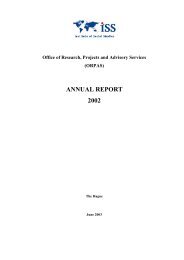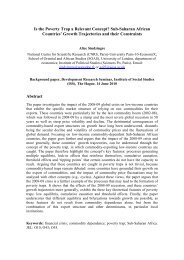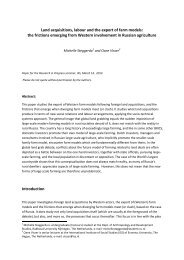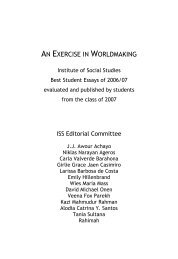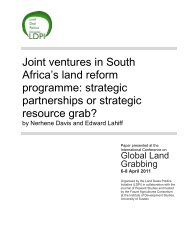AN EXERCISE IN WORLDMAKING 2009 - ISS
AN EXERCISE IN WORLDMAKING 2009 - ISS
AN EXERCISE IN WORLDMAKING 2009 - ISS
You also want an ePaper? Increase the reach of your titles
YUMPU automatically turns print PDFs into web optimized ePapers that Google loves.
22 <strong>AN</strong>DREA NICOLE DYKSHOORN<br />
kinson, 2002), schools often see it as the best option for students. An<br />
example of this is seen in a report submitted to the Manitoba government<br />
by Sisler High School in Winnipeg:<br />
[The integration programme] considers itself effective but is concerned<br />
about unrealistic goals being placed on ESL learners, particularly in cases<br />
where it is not going to be possible to see students graduate from the regular<br />
programme by the time they are 18 years of age. In such cases, it may<br />
be preferable to gear instruction towards employment. (Manitoba Education,<br />
Citizenship, and Youth, 2005:65).<br />
For Sisler High School, accommodating refugee students meant providing<br />
a streamed education-for-work track. No mention is made of offering<br />
a modified version of the regular programme so that refugee students<br />
are not streamed out of general or university-directed programmes.<br />
This sets a dangerous precedent for school policy, making “lower-level”<br />
streaming an easy, convenient alternative to deeper structural changes<br />
that could empower students rather than pushing them into low-paying<br />
jobs. According to Yau (1995), the percentage of refugee students in<br />
non-academic educational streams was higher than one-third, as compared<br />
to one-quarter of immigrant and Canadian-born students. However,<br />
what she finds most concerning is the fact that 19 percent of refugee<br />
students in these non-academic streams aspired to attend university,<br />
compared to 4 percent of other students (Yau, 1995: v). This discrepancy<br />
between the aspirations of students and the reality of their placement<br />
reflects a serious lack of agency on the part of refugee students.<br />
The streaming of students suggests that the education system is failing<br />
to find ways of enabling and encouraging refugee students to access the<br />
programmes available to the general student population. Li (2003) argues<br />
that integration must “take into account how Canadian institutions perform<br />
toward newcomers” (330). The streaming of refugee students can<br />
be seen as a symptom of a greater problem—the inflexibility of the education<br />
system in accommodating a population with distinct needs.<br />
5. Hidden curriculum—the lived experience of refugee students in<br />
schools<br />
The cognitive outcomes of schooling receive much attention, and the<br />
success or failure of students is almost always assessed through these<br />
outcomes (Wilkinson, 2002). Both the placement and streaming of refugee<br />
students have implications for the acquisition of knowledge, and are




